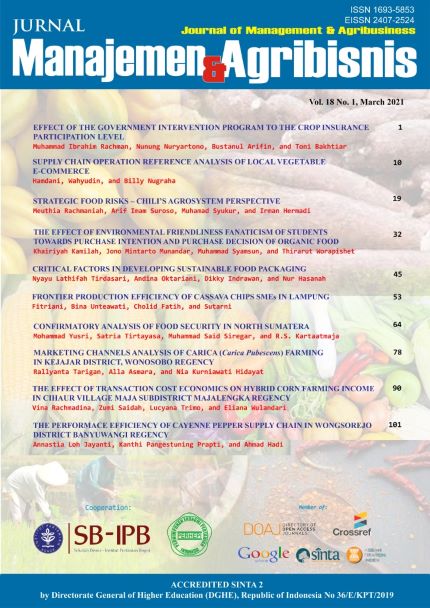Abstract
The prices of strategic food commodities, namely rice, red chili, chicken, beef, shallots, eggs, sugar, and cooking oil, are monitored to measure Indonesia's inflation in the food category. This study intended to explore the chili agrosystems as an essential Indonesian daily cuisine due to its perishable nature and its variably supply chain. The state-of-the-art approach from various research databases was used and supplemented with secondary data gathered from the related enterprise. The study revealed that food strategic web-based information systems on production, consumption, and price are under different authorities. Concerning the chili case, even though there was a production surplus, price fluctuation increasing the risk of lowering motivation to plant. The number of actors involved itemizes eight chili's supply chain main patterns. In conclusion, chili trade and freight margins favoured supply chain actors but not the farmer itself. The welfare of the farmers is not good condition. It is characterized by proxy indicators, the majority of which are only slightly more than 100. The situation creates a new risk of decreasing motivation in farming. Further study using manageable chili enterprise systems is required to bring farmers closer to end consumers and improve their welfare.
Keywords: chili agrosystem, decision support system, enterprise system, strategic food, supply chain
Authors
Authors who publish with this journal agree to the following terms:
- Authors retain copyright and grant the journal right of first publication with the work simultaneously licensed under a Creative Commons Attribution License that allows others to share the work with an acknowledgement of the work's authorship and initial publication in this journal.
- Authors are able to enter into separate, additional contractual arrangements for the non-exclusive distribution of the journal's published version of the work (e.g., post it to an institutional repository or publish it in a book), with an acknowledgement of its initial publication in this journal.
- Authors are permitted and encouraged to post their work online (e.g., in institutional repositories or on their website) prior to and during the submission process, as it can lead to productive exchanges, as well as earlier and greater citation of published work (See The Effect of Open Access).

